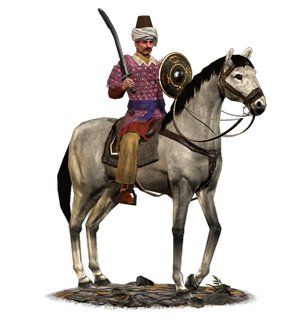Difference between revisions of "Barawardi (ETW Unit)"
Tango12345 (talk | contribs) m (Quick-adding category "Empire Total War Units" (using HotCat)) |
Tango12345 (talk | contribs) m (Quick-adding category "ETW Cavalry" (using HotCat)) |
||
| Line 24: | Line 24: | ||
[[Category:Empire Total War Units]] | [[Category:Empire Total War Units]] | ||
| + | [[Category:ETW Cavalry]] | ||
Revision as of 12:09, 5 September 2011
Barawardi are an elite light cavalry force. Despite wearing armour, they are surprisingly quick on the battlefield.
Overview
Equipped with helmets and cuirasses, they also carry swords. Their charge is not particularly powerful, but they can give a very good account of themselves in melee. Like other light cavalry, barawardi can be used to ride down skirmishers and disorganised enemies. If properly handled, they may well be able to close with artillery units without suffering too many casualties. However, they should not be committed against heavier cavalry forces, as they will suffer disproportionate losses, and require exceptional luck, or a very good commander, to be able to break an infantry square.
Cavalry was the most important element in Mughal armies, and it seems likely that all cavalrymen were well-trained fighters - expected to be physically fit and proficient horsemen. Men served in ethnically-based units, so Afghans would fight under Afghan officers, Rajputs with their own, and so on. This naturally created unit camaraderie and cohesion, because men were unlikely to let their own kith and kin die unduly. The cavalry were, however, not always trusted: their mounts would be branded with both imperial and the unit commander’s marks. This was to stop soldiers selling their good horses and enlisting as infantrymen, or from substituting inferior horseflesh. With harsh laws to punish thieves, there was therefore no market for horses carrying army marks.
